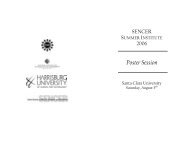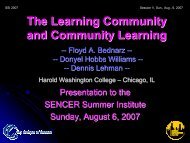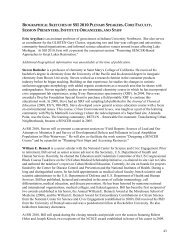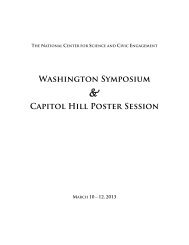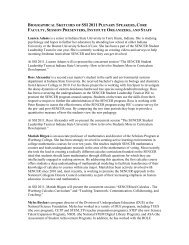Wetter, Wilder and Deeper: An Update on Linked ... - SENCER
Wetter, Wilder and Deeper: An Update on Linked ... - SENCER
Wetter, Wilder and Deeper: An Update on Linked ... - SENCER
You also want an ePaper? Increase the reach of your titles
YUMPU automatically turns print PDFs into web optimized ePapers that Google loves.
<str<strong>on</strong>g>Wetter</str<strong>on</strong>g>, <str<strong>on</strong>g>Wilder</str<strong>on</strong>g> <str<strong>on</strong>g>and</str<strong>on</strong>g> <str<strong>on</strong>g>Deeper</str<strong>on</strong>g>: <str<strong>on</strong>g>An</str<strong>on</strong>g><str<strong>on</strong>g>Update</str<strong>on</strong>g> <strong>on</strong> <strong>Linked</strong>Interdisciplinary <strong>Linked</strong> CoursesPearl Ramola Fern<str<strong>on</strong>g>and</str<strong>on</strong>g>esMary Ellen BellancaMichael R. Bac<strong>on</strong>John LogueUniversity of South Carolina Sumter
ObjectivesDevelop a learning community composedof ENGL 102 where the students studyliterature pertaining to natural history<str<strong>on</strong>g>and</str<strong>on</strong>g> wetl<str<strong>on</strong>g>and</str<strong>on</strong>g>s, <str<strong>on</strong>g>and</str<strong>on</strong>g> ENVR 101 with aspecial focus <strong>on</strong> southeastern wetl<str<strong>on</strong>g>and</str<strong>on</strong>g>sissues
Make informati<strong>on</strong> based <strong>on</strong> quantitativeanalysis <str<strong>on</strong>g>and</str<strong>on</strong>g> mathematical modelingless intimidating for students who mayhave limited math <str<strong>on</strong>g>and</str<strong>on</strong>g> sciencebackgrounds
Develop Develop coordinated delivery strategiesfor interdisciplinary learning <str<strong>on</strong>g>and</str<strong>on</strong>g> civicengagement
Assess Assess learning in our linked courses
Why Choose Wetl<str<strong>on</strong>g>and</str<strong>on</strong>g>s?Sumter Sumter <str<strong>on</strong>g>and</str<strong>on</strong>g> surrounding counties formpart of the Coastal Plain PhysiographicProvince of South Carolina
Envir<strong>on</strong>mental issues such aswetl<str<strong>on</strong>g>and</str<strong>on</strong>g>s delineati<strong>on</strong>, use, <str<strong>on</strong>g>and</str<strong>on</strong>g>protecti<strong>on</strong> have direct impact <strong>on</strong>students <str<strong>on</strong>g>and</str<strong>on</strong>g> the communities ofour immediate service areas.
Proximity Proximity of the water table toground surface is a primarydeterminant for a large number ofecological community types withinthis area. Thus wetl<str<strong>on</strong>g>and</str<strong>on</strong>g>s are ac<strong>on</strong>spicuous element of thel<str<strong>on</strong>g>and</str<strong>on</strong>g>scape.
TeamInterdisciplinaryEnglish English <str<strong>on</strong>g>and</str<strong>on</strong>g> Biology- to c<strong>on</strong>nectliterature to natural envir<strong>on</strong>mentMathematics- to analyze <str<strong>on</strong>g>and</str<strong>on</strong>g> interpretdata in biology
Interdisciplinary ApproachUtilize Utilize an interdisciplinary approach toteach undergraduates about thenature <str<strong>on</strong>g>and</str<strong>on</strong>g> importance of wetl<str<strong>on</strong>g>and</str<strong>on</strong>g>s
English 102 <str<strong>on</strong>g>and</str<strong>on</strong>g> Envir<strong>on</strong>ment 102 wereoffered as coupled courses in Fall 2005<str<strong>on</strong>g>and</str<strong>on</strong>g> Spring 2007. Students wereencouraged to enroll in both courses tomaximize their learning experience <str<strong>on</strong>g>and</str<strong>on</strong>g>minimize some of the work that mightotherwise be required to complete thetwo courses independently.
The Faculty
ENGLISH 102 Brochure“Gators <str<strong>on</strong>g>and</str<strong>on</strong>g> turtles <str<strong>on</strong>g>and</str<strong>on</strong>g> swamps—oh,my!”Register for a special secti<strong>on</strong> ofENGL 102, Compositi<strong>on</strong> <str<strong>on</strong>g>and</str<strong>on</strong>g> LiteraturecalledWET AND WILD: LITERATURE ANDNATURE OF THE SOUTHEAST
Themes <str<strong>on</strong>g>and</str<strong>on</strong>g> Readings
Nature in <str<strong>on</strong>g>An</str<strong>on</strong>g>cient NarrativesAesop’s s fablesJ<strong>on</strong>ah <str<strong>on</strong>g>and</str<strong>on</strong>g> the great fish (OldTestament)African-American American folktaleNative American creati<strong>on</strong> stories
Water, Destructi<strong>on</strong>, <str<strong>on</strong>g>and</str<strong>on</strong>g>Renewal T.C. Boyle, “Greasy Lake” Flannery O’C<strong>on</strong>nor,O“The River”
<str<strong>on</strong>g>An</str<strong>on</strong>g>imal Encounters Sarah Orne Jewett, “A A White Her<strong>on</strong>” Zora Neale Hurst<strong>on</strong>, “Sweat”
<str<strong>on</strong>g>An</str<strong>on</strong>g>imal EncountersSnakes <str<strong>on</strong>g>and</str<strong>on</strong>g> Cultural AttitudesAesop, “The Woodman <str<strong>on</strong>g>and</str<strong>on</strong>g> the Serpent”Snake = treachery, evilDiscuss: Imagine the snake’s s point ofviewWhy this animal for this moral?
Snakes in Literature: variousmessages– Native American Myths– Hurst<strong>on</strong>, “Sweat”– Whitman, “Castoff Skin”– Lawrence, “Snake”
Showcase of <strong>SENCER</strong> Activity Natural Reflecti<strong>on</strong>s-Fall 2005 Special exhibit <strong>on</strong> early editi<strong>on</strong>s ofnature literature- Spring 2007
ENVIRONMENT 101
Objectives Promote betterunderst<str<strong>on</strong>g>and</str<strong>on</strong>g>ing of thenatural world Increase awareness ofproblems resulting fromhuman interacti<strong>on</strong> with theenvir<strong>on</strong>ment Stress the interdisciplinarynature of the issues Encourage scientificproblem solving Encourage an active rolein envir<strong>on</strong>mental issues
Course Requirements 3 Examinati<strong>on</strong>s – 300 pts 10 Eco-Footprints/Quizzes– 100 pts Written Assignment – 25 pts Letter to Public Official – 25 pts Final Examinati<strong>on</strong> – 200 pts
Written Assignment Wetl<str<strong>on</strong>g>and</str<strong>on</strong>g>s from the perspective of ENGL 102assigned readings Wetl<str<strong>on</strong>g>and</str<strong>on</strong>g>s-ecologyformati<strong>on</strong>physiographyhistoryec<strong>on</strong>omicslegislati<strong>on</strong>
Examples of papersCarolina bays—what we know <str<strong>on</strong>g>and</str<strong>on</strong>g> d<strong>on</strong>’t t knowabout this mysteryMercury <str<strong>on</strong>g>and</str<strong>on</strong>g> other toxins in SC’s s p<strong>on</strong>ds <str<strong>on</strong>g>and</str<strong>on</strong>g>streamsThe reappearance of the “Lord God bird,” theivory-billed woodpecker, feared extinct fordecadesThe c<strong>on</strong>troversial “Clyburn c<strong>on</strong>nector,” a bridge<str<strong>on</strong>g>and</str<strong>on</strong>g> highway over the C<strong>on</strong>garee Swamp proposedby C<strong>on</strong>gressman Jim Clyburn
Civic Engagement Letter to public official <strong>on</strong> a localenvir<strong>on</strong>mental issue Site visits to local l<str<strong>on</strong>g>and</str<strong>on</strong>g>fill, recyclingcenters, <str<strong>on</strong>g>and</str<strong>on</strong>g> waste water treatmentfacilities Interacti<strong>on</strong> with local officials Field trips to local wetl<str<strong>on</strong>g>and</str<strong>on</strong>g> areas <str<strong>on</strong>g>and</str<strong>on</strong>g>to sites of wetl<str<strong>on</strong>g>and</str<strong>on</strong>g> alterati<strong>on</strong> <str<strong>on</strong>g>and</str<strong>on</strong>g>destructi<strong>on</strong>
Ecological Footprints On each lecture topic, students wererequired either to complete an ecologicalimpact (footprint) exercise or to completea 10-15 15 questi<strong>on</strong> pre-lecture quiz
Examples of In-Class Films Arctic Meltdown Rising Seas- How does thisdestabilize northern native <str<strong>on</strong>g>and</str<strong>on</strong>g> wildlife Arctic Quest: Search for Truth- Oil drilling in theAlaskan nati<strong>on</strong>al wilderness Sustainable Futures- Restorati<strong>on</strong> of watersheds,ecotourism <str<strong>on</strong>g>and</str<strong>on</strong>g> natural resource management inMexico, preserve spawning ground for salm<strong>on</strong> inthe north west Renewable Power- Fuel cells
Envir<strong>on</strong>mental Research Presentati<strong>on</strong>s by department facultyc<strong>on</strong>ducting research <strong>on</strong> “Water QualityIssues” in Pocotaligo Swamp near thelocal wastewater treatment facility
Wetl<str<strong>on</strong>g>and</str<strong>on</strong>g>s <str<strong>on</strong>g>and</str<strong>on</strong>g> Wetl<str<strong>on</strong>g>and</str<strong>on</strong>g>Destructi<strong>on</strong>
Sparkleberry Swamp-Cypress
Fresh Water Marsh- Cattails
Carolina Bays– Low AltitudePhoto
Carolina Bays– AgriculturalAlterati<strong>on</strong>
Carolina Bay near USC Sumter <str<strong>on</strong>g>and</str<strong>on</strong>g>its development
ExamplesLaboratory SamplingStrategies <str<strong>on</strong>g>and</str<strong>on</strong>g> <str<strong>on</strong>g>An</str<strong>on</strong>g>alysis N<strong>on</strong>-Grass Species in Campus Lawn Populati<strong>on</strong> Size Estimate <str<strong>on</strong>g>and</str<strong>on</strong>g>Parameters Sample Collecti<strong>on</strong> of Data from ThreePopulati<strong>on</strong>s of Live Oaks <strong>on</strong> Campus. Compilati<strong>on</strong> <str<strong>on</strong>g>and</str<strong>on</strong>g> <str<strong>on</strong>g>An</str<strong>on</strong>g>alysis of Data bya Mathematician
Math Comp<strong>on</strong>ent The purpose of the math comp<strong>on</strong>ent is tointroduce the student to the various thevarious ways mathematical c<strong>on</strong>cepts areused in biology. The main problem I encountered inintroducing mathematics was to limit howmuch mathematics to introduce. It was decided to introduce the student totwo topics based up<strong>on</strong> their ownparticipati<strong>on</strong> in the course labs.
Topics Basics of reporting <str<strong>on</strong>g>and</str<strong>on</strong>g> computing values inscientific studies. Basic Descriptive Statistics These topics were chosen based <strong>on</strong> an analysisof the data collected by the students in labs.– Data collecti<strong>on</strong> <strong>on</strong> a sample of sea shells– Data collecti<strong>on</strong> <strong>on</strong> live oaks of approximately thesame age living in close proximity, but in threedifferent envir<strong>on</strong>ments around campus.
Basics of reporting <str<strong>on</strong>g>and</str<strong>on</strong>g> computingvalues in scientific studies.– Types of numbers in science Exact vs. Approximate– Precisi<strong>on</strong> <str<strong>on</strong>g>and</str<strong>on</strong>g> Accuracy– Accuracy refers to how closely a measured value agrees withthe correct value. One Odetermines the accuracy of aninstrument by calibrati<strong>on</strong>, e.g. , measuring a knowndistance, known volume, or known mass.– Precisi<strong>on</strong> refers to how closely individual measurements agreewith each other.– Reporting Data Significant Figures or Digits (<strong>on</strong>ly deals with precisi<strong>on</strong>) Computati<strong>on</strong>s with Significant Figures.– Multiplicati<strong>on</strong>, Divisi<strong>on</strong>, Root Extracti<strong>on</strong>, i.e., complexmathematical operati<strong>on</strong>s– Additi<strong>on</strong> <str<strong>on</strong>g>and</str<strong>on</strong>g> Subtracti<strong>on</strong>
<str<strong>on</strong>g>An</str<strong>on</strong>g>alysis of Student DataDataIsolated in Lot Edge of Lot Not Boardered by LotOak DBH HT CROWN DBH HT CROWN DBH HT CROWN43.1 7 11.36 74.4 11 16.14 65.4 15 14.3247.8 6 11.86 85.1 15 15.34 64.7 15 14.655.8 11 11.38 67.9 13 15.86 60.4 11 13.246.7 8 12.36 58.2 12 15.36 62.8 14 15.8537 7 8 86.2 15 17.1 57.3 13 14.8354.5 10 13.7 73 16 15.94 61.9 16 15.6738.3 10 10.86 64.7 13 13.73 51 11 14.9343.3 8 9.72 65 12 13.24 70.3 15 14.634.5 8 7.56 57.2 12 13.23 50.3 10 12.1428.2 7 7.18 59.4 13 12.9 73.5 16 17.6Average 42.9 8 10.40 69.1 13 14.88 61.8 14 14.77Median 43.2 8 11.1 66.5 13 15.35 62.4 14.5 14.72Sometimes the above is violated due todefiniti<strong>on</strong>.Your reported values should reflect the precisi<strong>on</strong> of themeasurement.Your reported computati<strong>on</strong>s should not be more precise thanyour measurements.
Descriptive StatisticsMeasures of Central TendencyMeasures Locati<strong>on</strong>– Mean (average)– Median– ModeMeasures of Variance– Min, Max, <str<strong>on</strong>g>and</str<strong>on</strong>g> Range– Sample vs. Entire Populati<strong>on</strong>– Variance <str<strong>on</strong>g>and</str<strong>on</strong>g> St<str<strong>on</strong>g>and</str<strong>on</strong>g>ard Deviati<strong>on</strong>
1496.Sample1: X =401511.Sample 2: X =401499.Sample 3: X =401606.Sample 4: X =401445.Sample 5: X =401502.Sample 6: X =40≈ 37.40≈ 37.78≈ 37.48≈ 40.15≈ 36.13≈ 37.55Sample 1 Sample2 Sample 3 Sample 4 Sample 5 Sample 6i X i X i X i X i X i X i1 22 26 25 19 20 242 24 26 25 20 20 27Soluti<strong>on</strong>3 24 27 29 25 20 294 25 28 29 28 25 295 25 28 30 34 25 306 26 31 30 35 30 307 27 32 30 35 30 318 27 32 30 36 30 319 28 33 31 36 30 3110 29 34 31 37 30 3111 29 34 32 37 30 3212 30 34 32 38 30 3213 31 35 32 38 30 3314 32 35 33 38 30 3315 33 36 34 38 30 3516 33 36 35 38 30 3617 34 37 36 39 30 3618 35 37 37 40 35 3719 37 37 37 40 35 3720 37 38 37 40 35 3821 38 38 37 40 35 3822 38 38 38 41 35 3823 38 39 38 41 35 3924 40 39 38 41 35 3925 40 40 38 42 35 4026 41 40 40 42 35 4027 42 40 40 44 40 4028 43 41 41 44 40 4129 44 42 42 45 40 4130 44 42 42 45 45 4231 44 42 43 45 45 4232 44 43 43 45 45 4333 46 43 44 47 45 4334 49 44 44 47 45 4435 50 44 45 48 45 4436 52 45 46 48 50 4537 52 46 47 50 50 4538 52 48 50 50 50 4639 55 50 51 55 60 5240 56 51 57 55 60 58
4 511111123413423423414576123123123555555514001111111111111111111373875747574757572757275757575757575757575ExampleThe Good; the Bad; <str<strong>on</strong>g>and</str<strong>on</strong>g> the UglyPopulati<strong>on</strong> 1 Populati<strong>on</strong> 2 Populati<strong>on</strong> 3 Populati<strong>on</strong> 4 Populati<strong>on</strong> 5Average 37.4 37.775 37.475 37.925 37.775Median 37.5 38 37 3 37.5SD 9.46 6.2229 7.1554 218.11 35.864Two fictitious populati<strong>on</strong>s to illustrate why a combinati<strong>on</strong> ofstatistics are used in data analysis
Assessment- ENGL 102
Assessment- ENVR 101
Pre <str<strong>on</strong>g>and</str<strong>on</strong>g> Post Assessment Tests Part A (1-14)14) - General Knowledge –Science <str<strong>on</strong>g>and</str<strong>on</strong>g> Ecology Part B – (15-17) 17) Civic Engagement Part C – (18, 19) Culture, Philosophy <str<strong>on</strong>g>and</str<strong>on</strong>g>Literature
Pre- Test Part A – Average score of 5 out of 14,36% Part B – #15. Average of 5.79 correct#16. 14 of 19 students did not know <strong>on</strong>eof the indicated officials. #17. Two of 19students had communicated with a publicofficial. Part C – #19. Two of 19 resp<strong>on</strong>ded. Onelisted two sources
Post -Test Part A – Average score of 9/14,64.3% Part B - #15, Average of 7.8 out of10 #16, 12 of 19 knew at least<strong>on</strong>e official, but <strong>on</strong>ly <strong>on</strong>e knew 4.#17, 15 of 19 had written a publicofficial. Part C - #19, 8 students reported aliterary source infused withreferences to nature. Four of thosestudents were in Dr. Bellanca’s s class.
Envir<strong>on</strong>ment 101Lab –Ecological Footprint Score Pre – Assessment vs. Post-Assessment Score range from 0 (best) – 300(worst) Pre Assessment Av = 167.7, Post =123.0 All scores improved within a range of11 to 88 pts.
C<strong>on</strong>clusi<strong>on</strong>By the end of the semester studentshad developed some appreciati<strong>on</strong> ofwetl<str<strong>on</strong>g>and</str<strong>on</strong>g>s <str<strong>on</strong>g>and</str<strong>on</strong>g> were able to betterunderst<str<strong>on</strong>g>and</str<strong>on</strong>g> the interdependencebetween society <str<strong>on</strong>g>and</str<strong>on</strong>g> theenvir<strong>on</strong>ment, <str<strong>on</strong>g>and</str<strong>on</strong>g> how ec<strong>on</strong>omicdecisi<strong>on</strong>s made by humans impactedthe envir<strong>on</strong>ment.
Problems <str<strong>on</strong>g>and</str<strong>on</strong>g> Successes Few c<strong>on</strong>current students Laboratory is not a required part ofENVR 101 Problems with <strong>SENCER</strong>-SALGSALG Based <strong>on</strong> written resp<strong>on</strong>ses <str<strong>on</strong>g>and</str<strong>on</strong>g>improvement in their eco-footprintscores, students seemed more awareof their impact <strong>on</strong> the envir<strong>on</strong>ment
Recommendati<strong>on</strong>s?



